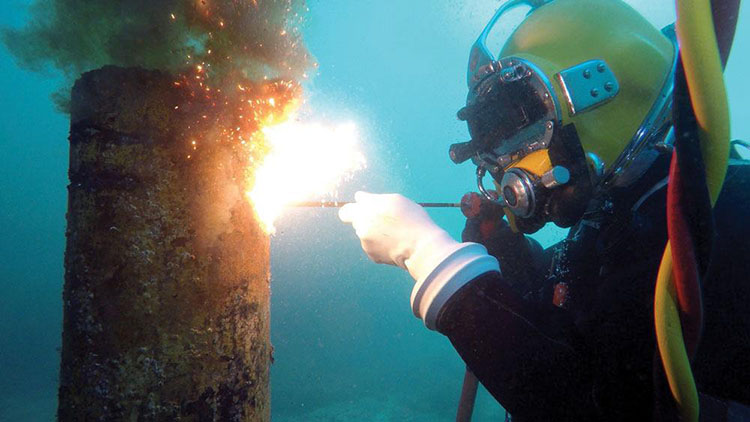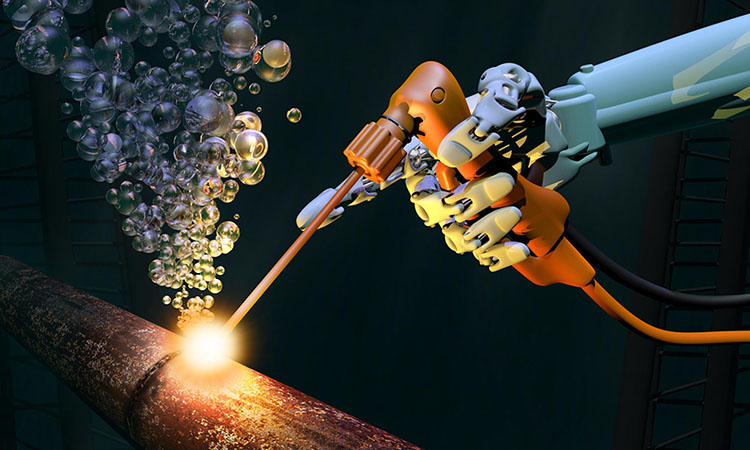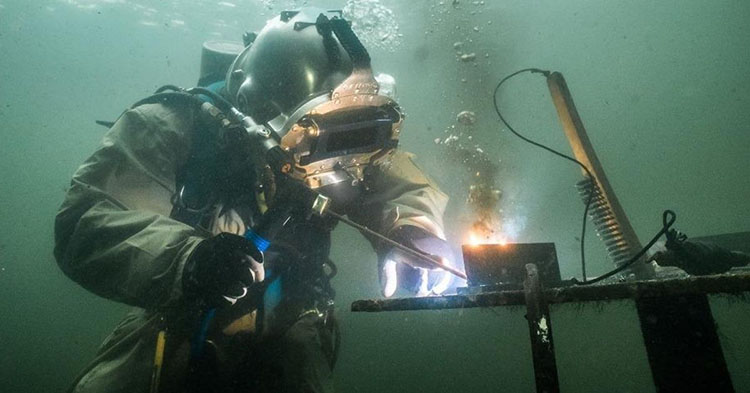There are three types of underwater welding: dry method, wet method and partial dry method.
Dry welding
This is a method in which a large air chamber is used to cover the weldment, and the welder performs welding in the air chamber. Since the welding is performed in a dry gas phase, its safety is better. When the depth exceeds the diving range of the air, sparks are easily generated due to the increase of the local oxygen pressure in the air environment. Therefore, an inert or semi-inert gas should be used in the gas chamber. During dry welding, welders should wear special fireproof and high temperature resistant protective clothing. Compared with wet and partial dry welding, dry welding has the best safety, but its use is very limited and its application is not universal.
partial dry welding
The local dry method is an underwater welding method in which the welder performs welding in water and artificially drains the water around the welding area, and its safety measures are similar to those of the wet method.
Since the spot dry method is still under research, its use is not yet widespread.
Wet welding
Wet welding is an underwater welding method in which the welder directly welds underwater instead of artificially draining the water around the welding area.
Arc burning under water is similar to submerged arc welding, and it burns in air bubbles. When the electrode burns, the coating on the electrode forms a sleeve that stabilizes the air bubbles and thus stabilizes the arc. In order to make the electrode burn stably underwater, it is necessary to coat a certain thickness of coating on the electrode core and impregnate it with paraffin or other waterproof substances to make the electrode waterproof. Bubbles are hydrogen, oxygen, water vapor and bubbles produced by the combustion of electrode coatings; other oxides produced by turbid smoke. In order to overcome the difficulty of arc ignition and arc stabilization caused by water cooling and pressure, the arc ignition voltage is higher than that in the atmosphere, and its current is 15% to 20% larger than the welding current in the atmosphere.
Compared with dry and partial dry welding, underwater wet welding has the most applications, but the safety is the worst. Due to the conductivity of water, protection against electric shock is one of the main safety concerns of wet welding.
Wet underwater welding is performed directly in deep water, that is, under the condition that there is no mechanical barrier between the welding area and the water. The welding is not only affected by the ambient water pressure, but also strongly cooled by the surrounding water.
Although wet underwater welding is convenient and flexible, and requires simple equipment and conditions, due to the strong cooling of the welding arc, molten pool, electrode and welding metal by water, the stability of the arc is destroyed, and the weld shape is poor. The hardened zone is formed in the welding heat-affected zone, and a large amount of hydrogen is intruded into the arc column and molten pool during the welding process, which may lead to defects such as welding cracks and pores. Therefore, wet underwater welding is generally used in shallow water areas with good ocean conditions and welding of components that do not require high stress.
The underwater environment makes the underwater welding process much more complicated than the land welding process. In addition to welding technology, it also involves many factors such as diving operation technology. The characteristics of underwater welding are:
1. Low visibility. The absorption, reflection and refraction of light by water is much stronger than that of air. Therefore, light weakens rapidly when it propagates in water. In addition, a large number of bubbles and smoke are generated around the arc during welding, making the underwater arc very low in visibility. Underwater welding is carried out in muddy seabed and sea area with sand and mud, and the visibility in water is even worse.
2. The weld seam contains high hydrogen content, and hydrogen is the enemy of welding. If the hydrogen content in welding exceeds the allowable value, it is easy to cause cracks and even lead to structural damage. The underwater arc will cause thermal decomposition of the surrounding water, resulting in an increase in the hydrogen dissolved in the weld. The poor quality of the welded joints of underwater electrode arc welding is inseparable from the high hydrogen content.
3. The cooling speed is fast. When welding underwater, the thermal conductivity of seawater is high, which is about 20 times that of air. If the wet method or local method is used for underwater welding, the workpiece to be welded is directly in the water, and the quenching effect of the water on the weld is obvious, and it is easy to produce a high-hardness hardened structure. Therefore, the cold effect can only be avoided when dry welding is used.
4. The influence of pressure, as the pressure increases, the arc column becomes thinner, the width of the weld bead becomes narrower, the height of the weld seam increases, and the density of the conductive medium increases, which increases the difficulty of ionization, the arc voltage increases accordingly, and the arc stability Reduced, increased splash and smoke.
5. Continuous operation is difficult to realize. Due to the influence and limitation of the underwater environment, in many cases, the method of welding for one section and stopping for one section has to be adopted, resulting in discontinuous welds.
The safety of wet underwater welding is much worse than that on land. The main safety measures are:
Direct current should be used for underwater welding, and alternating current is prohibited. The no-load voltage is generally 50-80V. Control electrical appliances in direct contact with diving welders must use isolation transformers and be protected by overload. Before diving welders start operation or during the process of changing electrodes, they must notify land personnel to cut off the circuit. Diving welders must wear special protective clothing and special gloves. During arc ignition and arc continuation, hands should be avoided from touching workpieces, cables, welding rods, etc. When welding on a live structure, the current on the structure should be cut off first. During underwater welding operations, labor hygiene protection, especially urban protection and burn protection should be provided. Regularly check the insulation performance and waterproof performance of underwater welding equipment, welding tongs, cables, etc.
Post time: Jul-12-2023



